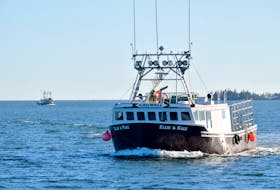HILDEN, N.S. — There’s one very prickly – although extremely cute – orphan being cared for at the Cobequid Wildlife Rehabilitation Centre. A baby porcupine – or a porcupette – is the centre’s first baby of the season.
“When people saw her, she was dragging the umbilical cord and placenta,” said Brenda Boates, a wildlife rehabilitator at the CWRC. “She was calling for her mother, so they watched for a while, but the mother never showed up.”
The youngster was found on Easter Sunday and arrangements were made to deliver her to the wildlife centre, where she was fed a specially prepared formula.
Those working with her have to wear gloves because, although this animal isn’t concerned about having people nearby, a porcupette’s quills harden within about four hours of birth.
“She’s down to one feeding of formula per day and is now eating some grass, dried apple, hay, twigs and cracked corn,” said Boates. “We try to keep the diet as natural as possible. As the season progresses we’ll add berries and fresh corn.”
Porcupines don’t imprint on their caregivers as quickly as baby birds, and don’t have great eyesight, so human faces don’t need to be hidden.
Although porcupettes are weaned early, they stay with their mother for several months, learning how to survive.
The little one at the CWRC will be moved into a large outdoor enclosure when she’s a little older, and her food will be hidden so she’ll learn to forage. If everything goes well, she’ll eventually be released into the wild.
Anyone who thinks a young animal might need help should observe from a distance to see if the mother returns. If help is needed, a rehabilitation centre should be contacted for advice.
“Having this as our first baby of the season is fitting because porcupines held a special place for Helene (VanDonick) and it’s one of the animals always connected with the CWRC,” said Boates.
A name
Although the animals at the CWRC are usually not named, the little porcupette could receive a name as part of a fundraising effort. By making a donation toward the animal’s care, people can suggest a name. Although the porcupette has been referred to as she, the sex is unknown.
The centre can be contacted through Facebook or at [email protected].
To the point
Porcupines are peaceful and will first try to run away from danger.
They chatter at enemies to warn them off.
Each animal has thousands of quills.
Adult males weigh about 5.5 kg and females can reach 4.5 kg.
They make very few sounds except during mating season, when they make a variety of noises.
Young are born seven months after mating and are weaned after about 10 days, but stay with their mother until fall.
They don’t hibernate, but don’t go far from their den during cold weather.
Other than humans, the porcupine’s most dangerous enemy is the fisher, a member of the weasel family.








